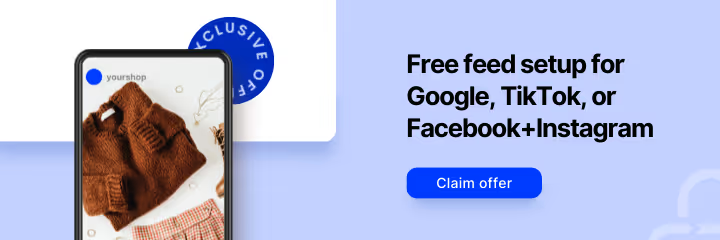An extensive and diverse catalog can help draw more customers, but for most retailers, a large portion of their revenue comes from just a few items. Those products that sell like crazy, sell at a high price-point, or cost you next-to-nothing. (And if you have a product that hits on all three of these criteria, you've got yourself a unicorn -- and even more reason to give it most of your attention.)
One of the most effective ways to bolster revenue is to focus on your highest-performing products.
But how do you do that? It's actually easier than you might think, so let's just dive right in.
Identify top performers.
You can’t throw your weight behind top performing products until you actually know which items are helping you the most. That’s where analytics come in.
Obviously, you should take a look at which items are selling the most. But you should dig deeper than that. Learn much you’re spending on them (manufacturing, advertising, shipping, and so on) versus what they sell for. In short, consider your return on investment for individual products.
Sifting through all the data to find this information doesn’t have to be time-consuming or daunting, either. GoDataFeed provides powerful and effective analytics tools that allow you to receive reports and alerts based on data points you choose. By tracking data like Cost of Sale Percentage (COS%) and Cost per Acquisition (CPA), you can more easily pinpoint your top-performing products.
Once you pinpoint what products are doing well, it’s time to help them do even better.
Keep them well-stocked.
You can’t sell an item that isn’t in stock! That’s lost revenue.
Worse, unless you are selling something that is completely unique and people can only get it from you, customers are likely to turn to another seller without thinking twice.
And finally, running out of stock on marketplace sites is likely to both hurt your seller rating and lead to some kind of consequence from the site itself.
Set up alerts, so you are always on top of reordering when you get low on a top-performing product. And remember to take into consideration the time it takes to manufacture or receive the inventory.
Optimize product pages.
Your product is selling. You’re making lots of money off of it. Your natural inclination may be to kick back and enjoy the ride – but if you do this, you’re likely to run out of gas quickly.
One of the best ways to maximize sales is to keep fine-tuning and improving the product page. Could you have better, newer images? A more detailed product description? Find better keywords? Product pages need to be living, evolving things if you want to not just get to the top, but stay there.
Shift marketing dollars.
This works in two ways:
One, shifting marketing dollars towards an item with a high ROI that is already doing well is likely to help it perform even better. More people will be able to find it. Your audience will expand. And most likely you will see an influx of sales.
Two, spending less on products that are not doing as well should improve your overall profitability. It doesn’t mean that you completely abandon items that aren’t top performers (as mentioned above, a diverse catalogue is typically a good thing), but moving your focus away from them is generally a wise idea.
When you shift marketing dollars, it can mean a number of things: changing your per-click ad spend; opting into (or out of) featured ads, remarketing, and so on; and moving your product to different or additional marketplaces where it may perform better.
Sell on more shopping channels.
In general, adding your top-performing products to Amazon and Google is a must. Why? Because 73% of online shoppers start their search on one of those two channels.
But there are many other shopping channels where you may find success (and less competition!). If it has been a number of years since you tried a particular marketplace, consider giving it another try. Marketplaces evolve over time, and so do their customers.
For example, NewEgg was once almost entirely focused on technology items, but has since expanded to include 17 product categories. And eBay’s “hot items” are changing so often that they have devoted an entire section of the site to help sellers identify the best items to sell.
Lower costs.
If you are selling thousands of a particular item, even a savings of a few cents can add up over time. See if you can work out a new deal with your vendors on anything from shipping material to manufacturing. If you are selling a lot more of a particular item than you were when you originally established your agreements, you may be eligible for volume price discounts you weren’t previously.
Also, look for ways to make the packing and shipping process more cost-efficient. Consider if going with a Fulfillment Program offered by a shopping channel, such as Fulfillment by Amazon or Shipped by Newegg, would improve or hurt your bottom line.
Offer accessories or related items.
Many marketplaces allow you to upsell or bundle products, so take advantage of your top-selling items to make more sales.
For example, if you sell a lot of a particular laptop, offer a laptop bag and additional charger to customers. Or consider developing related products. Don’t just consider products that customers need immediately after their purchase.
Consider if they will have any ongoing needs that you can promote to them later. For example, if you sell a printer, you could send them a reminder to buy new ink cartridges a month after their purchase.
And look at how their needs may change over time. For example, if you sell products for infants, you know your customers will have a toddler on their hands in the near future. So you can promote or develop products that will meet those future needs.
Run surveys.
You may know what your top-performing products are, but do you know why they are performing so well? Is it your price point? Specific features? Brand recognition? Customer service?
The best way to find out is to ask your customers. Look over product reviews, and then directly send people surveys. There are many tools, such as SurveyMonkey, that make this process simple.
Once you uncover the reasons for your top products’ success, you can more easily identify other potential product offerings – and hopefully add to that list of top performing products!
Final Thoughts
With today’s technology, retailers have never had more power – both to identify what’s working and to choose on a micro-level where to focus their efforts. Make use of it, and you’ll build a business that thrives not just today – but for the long-term.





%20).webp)